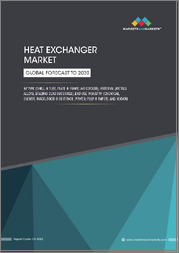
|
시장보고서
상품코드
1622831
아시아태평양의 마이크로채널 열교환기 시장 : 용도별, 제품별, 국가별 - 분석과 예측(2024-2033년)Asia-Pacific Microchannel Heat Exchanger Market: Focus on Application, Product, and Country - Analysis and Forecast, 2024-2033 |
||||||
아시아태평양의 마이크로채널 열교환기 시장 규모는 2024년 63억 300만 달러에서 2033년 155억 610만 달러에 이르고, 예측 기간의 2024-2033년 CAGR은 10.52%가 될 것으로 예측됩니다.
아시아태평양의 마이크로채널 열교환기 시장은 신재생에너지, 자동차, 난방·환기·공조(HVAC) 등 분야에서 에너지 효율적인 열관리 솔루션에 대한 요구가 높아지고 있기 때문에 급속히 확대되었습니다. 마이크로채널 열교환기는 특히 전기자동차로의 전환이 진행되고 효율적인 열 관리가 중요해짐에 따라 작고 고효율이기 때문에 큰 수요가 있습니다.
또한 환경 의식이 높아지고 재료 회수와 순환 형 경제 등 지속 가능한 관행에 대한 주목도 채용에 박차를 가하고 있습니다. 이에 따라 산업계는 친환경 솔루션을 점점 더 중시하고 있습니다.
| 주요 시장 통계 | |
|---|---|
| 예측 기간 | 2024-2033년 |
| 2024년 평가 | 63억 300만 달러 |
| 2033년 예측 | 155억610만 달러 |
| CAGR | 10.52% |
신재생에너지, 자동차, 난방·환기·공조(HVAC) 등 많은 분야에서 에너지 효율적인 열관리 솔루션에 대한 요구가 높아지고 있기 때문에 아시아태평양의 마이크로채널 열교환기 시장은 급성장하고 있습니다. 이 열교환기는 경량 설계, 뛰어난 열 성능, 컴팩트한 사이즈가 높게 평가되어 현대의 용도에 필수적입니다.
마이크로채널 열교환기의 채용은 이 지역의 전기차로의 시프트에 의해 가속되고 있으며, 고급 열 관리 시스템의 중요성이 더욱 부각되고 있습니다. 시스템을 최적화하고 에너지 효율성과 성능 향상을 보장하는 능력을 갖추고 있기 때문에 변화하는 자동차 산업에 필수적입니다.
아시아태평양에서는 환경의 지속가능성이 중요한 초점이 되고 있으며, 산업계는 폐기물과 탄소실적을 삭감하기 위해 순환경제의 원칙과 지속가능한 제조방법을 도입하고 있습니다. 교환기는 재활용 가능한 부품과 친환경 소재를 사용하여 이러한 목표를 지원하고 시장 점유율을 확대하고 있습니다.
본 보고서는 아시아태평양의 마이크로채널 열교환기 시장에 대해 조사했으며, 시장 개요와 함께 용도별, 제품별, 국가별 동향, 시장 진출기업 프로파일 등의 정보를 제공합니다.
목차
주요 요약
제1장 시장
- 동향 : 현재 및 미래의 영향 평가
- 공급망 개요
- 연구개발 리뷰
- 규제 상황
- 이해관계자 분석
- 주요 세계적 사건의 영향 분석-COVID-19, 러시아/우크라, 중동 위기
- 주요 개발과 진행중인 프로젝트
- 시장 역학:개요
제2장 지역
- 지역별 개요
- 성장 촉진요인과 억제요인
- 아시아태평양
제3장 시장 - 경쟁 벤치마킹 및 기업 프로파일
- 향후 전망
- 지리적 평가
- SANHUA HOLDING GROUP
- WELCON Inc.
- Shanghai Shenglin M&E Technology Co. Ltd.
- Zhejiang Dunan Artificial Environment Co. Ltd.
- Sumitomo Precision Products Co. Ltd.
제4장 조사 방법
JHS 25.01.09Introduction to Asia-Pacific Microchannel Heat Exchanger Market
The Asia-Pacific microchannel heat exchanger market is projected to reach $15,506.1 million by 2033 from $6,303.0 million in 2024, growing at a CAGR of 10.52% during the forecast period 2024-2033. The market for APAC microchannel heat exchangers is expanding quickly due to the growing need for energy-efficient thermal management solutions in sectors like renewable energy, automotive, and heating, ventilation, and air conditioning (HVAC). Microchannel heat exchangers are in great demand due to their small size and high efficiency, particularly as the area switches to electric vehicles and efficient thermal management becomes more important.
Adoption is also fueled by growing environmental consciousness and the focus on sustainable practices, such as material recovery and the circular economy. In line with the region's emphasis on lowering carbon emissions, industries are placing an increasing emphasis on environmentally friendly solutions. Furthermore, substantial R&D expenditures are boosting technological developments in microchannel heat exchangers.
| KEY MARKET STATISTICS | |
|---|---|
| Forecast Period | 2024 - 2033 |
| 2024 Evaluation | $6,303.0 Million |
| 2033 Forecast | $15,506.1 Million |
| CAGR | 10.52% |
Another important area of focus is supply chain resilience, which guarantees consistent growth and satisfies demands.
Market Introduction
The market for APAC microchannel heat exchangers is growing quickly due to the increasing need for energy-efficient thermal management solutions in a number of sectors, such as renewable energy, automotive, and heating, ventilation, and air conditioning (HVAC). These exchangers are highly valued for their lightweight design, excellent thermal performance, and compact size, which makes them indispensable in contemporary applications.
The adoption of microchannel heat exchangers has been accelerated by the region's shift to electric vehicles, which has further highlighted the significance of sophisticated thermal management systems. They are essential to the changing automotive landscape because of their capacity to optimize cooling systems in electric vehicles, guaranteeing energy efficiency and improved performance.
Environmental sustainability is a key focus in APAC, with industries implementing circular economy principles and sustainable manufacturing practices to reduce waste and carbon footprints. Microchannel heat exchangers' use of recyclable parts and environmentally friendly materials supports these goals and increases their market share.
Research and development expenditures are encouraging ongoing innovation, which leads to goods that are more robust, effective, and economical. Furthermore, initiatives to improve supply chain resilience are guaranteeing a consistent supply of goods to satisfy the expanding demand in the region.
The market for APAC microchannel heat exchangers is expected to grow steadily due to rising urbanization, industrialization, and sustainability awareness, which will help the region achieve its energy and environmental objectives.
Market Segmentation
Segmentation 1: by End-Use Industry
- Automotive
- HVAC
- Commercial Refrigeration
- Others
Segmentation 2: by Material Type
- Metal
- Ceramic
Segmentation 3: by Fluid Mechanism
- Single Coil
- Dual Coil
- Multi Coil
Segmentation 4: by Country
- China
- Japan
- South Korea
- India
- Rest-of-Asia-Pacific
How can this report add value to an organization?
Product/Innovation Strategy: This report provides a comprehensive product/innovation strategy for the apac microchannel heat exchanger market, identifying opportunities for market entry, technology adoption, and sustainable growth. It offers actionable insights, helping organizations leverage microchannel heat exchangers to meet environmental standards, gain a competitive edge, and capitalize on the increasing demand for eco-friendly solutions in various industries.
Growth/Marketing Strategy: This report offers a comprehensive growth and marketing strategy designed specifically for the microchannel heat exchanger market. It presents a targeted approach to identifying specialized market segments, establishing a competitive advantage, and implementing creative marketing initiatives aimed at optimizing market share and financial performance. By harnessing these strategic recommendations, organizations can elevate their market presence, seize emerging prospects, and efficiently propel revenue expansion.
Competitive Strategy: This report crafts a strong competitive strategy tailored to the apac microchannel heat exchanger market. It evaluates market rivals, suggests methods to stand out, and offers guidance for maintaining a competitive edge. By adhering to these strategic directives, companies can position themselves effectively in the face of market competition, ensuring sustained prosperity and profitability.
Table of Contents
Executive Summary
Scope and Definition
1 Markets
- 1.1 Trends: Current and Future Impact Assessment
- 1.1.1 Trends: Current and Future Impact Assessment
- 1.1.1.1 Rise in Demand for Microchannel Heat Exchangers (MCHEs) in the Manufacturing Industry
- 1.1.1.2 Rapid Growth of the Construction Industry Worldwide
- 1.1.1 Trends: Current and Future Impact Assessment
- 1.2 Supply Chain Overview
- 1.2.1 Value Chain Analysis
- 1.2.2 Market Map
- 1.2.2.1 Microchannel Heat Exchanger Market - by End-Use Industry
- 1.2.2.1.1 Automotive
- 1.2.2.1.2 Heating, Ventilation, and Air Conditioning (HVAC)
- 1.2.2.1.3 Commercial Refrigeration
- 1.2.2.1.4 Others
- 1.2.2.1 Microchannel Heat Exchanger Market - by End-Use Industry
- 1.2.3 Pricing Forecast
- 1.3 Research and Development Review
- 1.3.1 Patent Filing Trend (by Country and Company)
- 1.4 Regulatory Landscape
- 1.5 Stakeholder Analysis
- 1.5.1 Use Case
- 1.5.2 End User and Buying Criteria
- 1.6 Impact Analysis for Key Global Events-COVID-19, Russia/Ukraine, or Middle East Crisis
- 1.7 Major Developments and Ongoing Projects
- 1.8 Market Dynamics: Overview
- 1.8.1 Market Drivers
- 1.8.1.1 Stringent Environmental Standards and Energy Efficiency Regulations
- 1.8.1.2 High Demand from Heating, Ventilation, Air Conditioning, and Refrigeration (HVAC&R) Industry
- 1.8.1.3 Growing Need for Thermal Management in Data Centers
- 1.8.2 Market Restraints
- 1.8.2.1 High Costs of Production and Manufacturing Complexities
- 1.8.2.2 Concerns Regarding Reliability and Durability of Microchannel Heat Exchangers
- 1.8.3 Market Opportunities
- 1.8.3.1 Expanding Incorporation of Microchannel Heat Exchangers in Renewable Energy
- 1.8.3.2 Increasing Usage in the Automotive Industry
- 1.8.1 Market Drivers
2 Regions
- 2.1 Regional Summary
- 2.2 Drivers and Restraints
- 2.3 Asia-Pacific
- 2.3.1 Regional Overview
- 2.3.2 Driving Factors for Market Growth
- 2.3.3 Factors Challenging the Market
- 2.3.3.1 Application
- 2.3.3.2 Product
- 2.3.4 China
- 2.3.4.1 Application
- 2.3.4.2 Product
- 2.3.5 Japan
- 2.3.5.1 Application
- 2.3.5.2 Product
- 2.3.6 South Korea
- 2.3.6.1 Application
- 2.3.6.2 Product
- 2.3.7 India
- 2.3.7.1 Application
- 2.3.7.2 Product
- 2.3.8 Rest-of-Asia-Pacific
- 2.3.8.1 Application
- 2.3.8.2 Product
3 Markets - Competitive Benchmarking & Company Profiles
- 3.1 Next Frontiers
- 3.2 Geographic Assessment
- 3.2.1 SANHUA HOLDING GROUP
- 3.2.1.1 Overview
- 3.2.1.2 Top Products/Product Portfolio
- 3.2.1.3 Top Competitors
- 3.2.1.4 Target Customers
- 3.2.1.5 Key Personnel
- 3.2.1.6 Analyst View
- 3.2.1.7 Market Share, 2022
- 3.2.2 WELCON Inc.
- 3.2.2.1 Overview
- 3.2.2.2 Top Products/Product Portfolio
- 3.2.2.3 Top Competitors
- 3.2.2.4 Target Customers
- 3.2.2.5 Key Personnel
- 3.2.2.6 Analyst View
- 3.2.3 Shanghai Shenglin M&E Technology Co. Ltd.
- 3.2.3.1 Overview
- 3.2.3.2 Top Products/Product Portfolio
- 3.2.3.3 Top Competitors
- 3.2.3.4 Target Customers
- 3.2.3.5 Analyst View
- 3.2.3.6 Market Share, 2022
- 3.2.4 Zhejiang Dunan Artificial Environment Co. Ltd.
- 3.2.4.1 Overview
- 3.2.4.2 Top Products/Product Portfolio
- 3.2.4.3 Top Competitors
- 3.2.4.4 Target Customers
- 3.2.4.5 Key Personnel
- 3.2.4.6 Analyst View
- 3.2.4.7 Market Share, 2022
- 3.2.5 Sumitomo Precision Products Co. Ltd.
- 3.2.5.1 Overview
- 3.2.5.2 Top Products/Product Portfolio
- 3.2.5.3 Top Competitors
- 3.2.5.4 Target Customers
- 3.2.5.5 Key Personnel
- 3.2.5.6 Analyst View
- 3.2.5.7 Market Share, 2022
- 3.2.1 SANHUA HOLDING GROUP
4 Research Methodology
- 4.1 Data Sources
- 4.1.1 Primary Data Sources
- 4.1.2 Secondary Data Sources
- 4.1.3 Data Triangulation
- 4.2 Market Estimation and Forecast



















